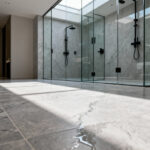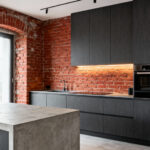Designing a bathroom is an act of material storytelling—every surface you choose reflects not just an aesthetic preference, but a deeper statement about how you want to feel in your most private moments. The most compelling spaces aren’t just decorated; they’re composed. They are symphonies of texture and light, built from an understanding that materials have memory, character, and a voice. These twenty truths separate an authentic, sensory-rich farmhouse bathroom renovation from a hollow imitation, guiding you toward a space that feels as good as it looks.
My work is built on a philosophy of material intelligence. A farmhouse bathroom succeeds or fails based on its synthesis of Mixed Material Design and intentional Texture Layering. This isn’t just about pairing wood with tile; it’s about the conversation between the cellular structure of reclaimed timber and the impervious, vitrified body of porcelain. It’s about understanding how the cool, dense presence of honed stone can balance the warm, oxidative patina of unlacquered brass. This guide deconstructs that process, moving from foundational principles to the nuanced artistry that transforms a functional room into a sanctuary of tactile richness and enduring quality.
We begin by establishing the architectonics of authenticity—the foundational rules of form and material that give this style its soul. From there, we explore the kinetic surfaces and structural truths that form the room’s core, focusing on the interplay of resilience and beauty. Finally, we ascend to the final layers of artistry, integrating transcendental textures and sculptural elements that elevate the narrative. This is the path to creating a farmhouse bathroom that is not just seen, but deeply felt.
Architectonics of Authenticity: Deconstructing the Farmhouse Aesthetic (Part 1)
Before a single tile is laid, we must understand the soul of the farmhouse style. This isn’t about replicating a look from a magazine; it’s about dissecting the principles that give it authenticity and gravitas. We begin with the most crucial balance of all: the marriage of rustic honesty and modern performance.
1. Marrying Rustic Form with Uncompromising Modern Function
A compelling farmhouse bathroom isn’t about rigid historical replication. It’s a sophisticated synthesis of enduring rustic forms with the sharp, clean performance of contemporary function. You’re creating an equilibrium where history and progress don’t compete—they elevate one another. When we talk about rustic form, we’re talking about the foundational language of the style: the raw grain of unfinished wood, the pockmarked face of exposed brick, the quiet story told by a salvaged metal bracket.
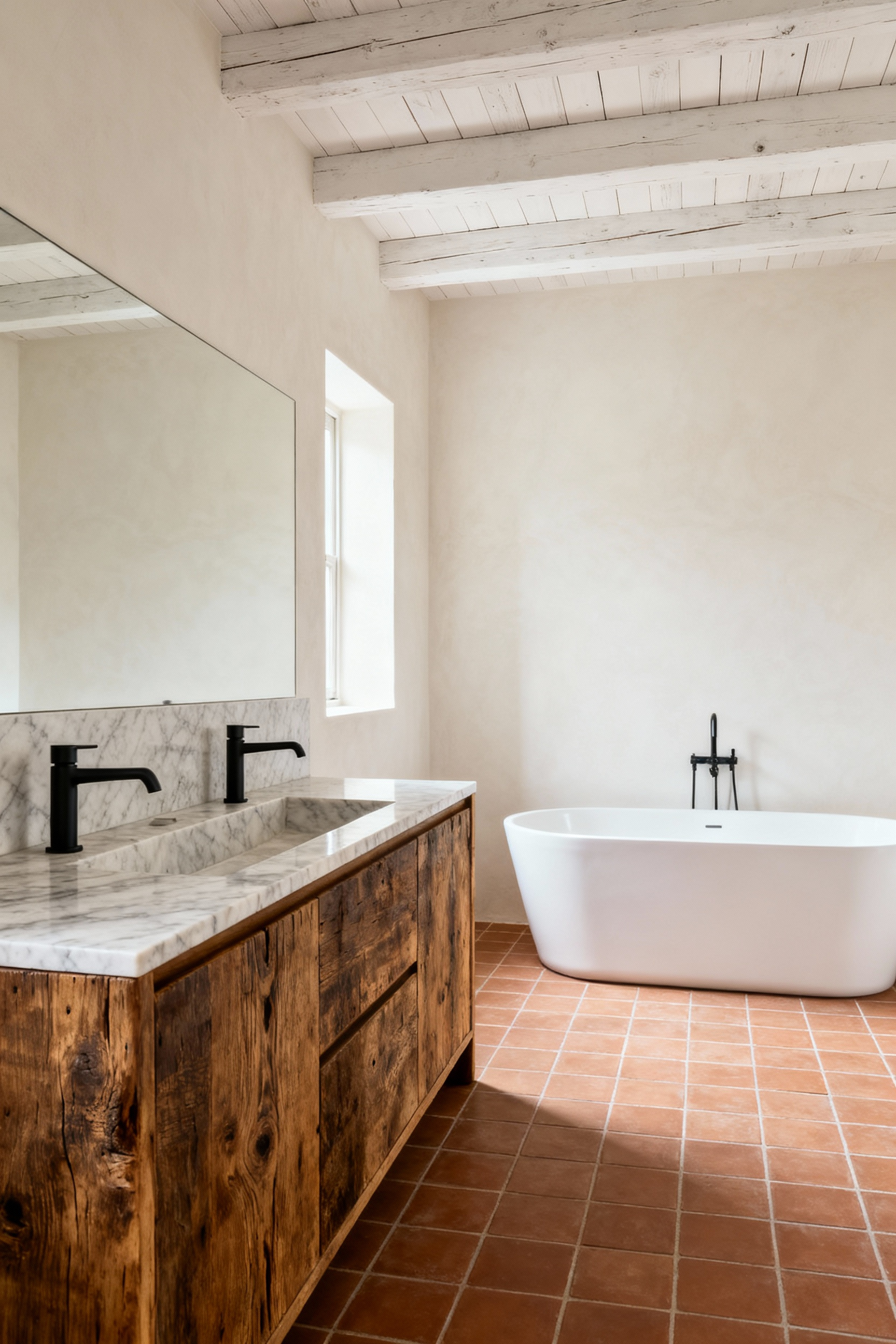
The trick is to weave in modern necessities so gracefully they feel inevitable. A sleek, frameless glass shower enclosure doesn’t fight with a distressed wood vanity; it frames it. Radiant floor heating can silently warm antique-look terracotta tiles from below. The key is choosing modern pieces with an honesty of their own—avoiding fussy plastics or anything that feels temporary. Think of matte black fixtures, whose sharp, geometric silhouette provides a modern counterpoint that makes the texture of a limewashed wall feel even more profound. This intentional dialogue is what keeps a farmhouse bathroom renovation feeling both timeless and entirely livable.
2. The Science of Reclaimed Timber in High-Moisture Zones
Reclaimed timber is the heartwood of the authentic farmhouse aesthetic. Each plank, with its nail holes and saw marks, carries a tangible history that new wood simply cannot fake. But bringing it into a bathroom—a space defined by steam and humidity—requires a deep understanding of material science. The romance of its story must be backed by rigorous preparation.

Not all woods are created equal here. Dense, old-growth species like oak or heart pine have a natural resistance to moisture, but that’s just the starting point. Proper sealing is non-negotiable. I recommend a marine-grade varnish or a high-performance polyurethane, chosen carefully to create an impervious barrier without giving the wood an artificial, plastic-like sheen. Placement is just as critical. Use it for vanity bases, ceiling beams, or shelving—areas that receive ambient humidity but aren’t in a direct splash zone. A vanity crafted from a salvaged beam instantly becomes the room’s anchor, its raw texture a perfect foil for a smooth porcelain sink. This is how you honor the wood’s past while securing its future.
3. The Art of Intentional Patina: Curating Imperfection
The farmhouse aesthetic finds its soul in the story of wear. It celebrates the beauty of a life well-lived. This isn’t about letting things fall apart; it’s a deliberate design choice I call the art of intentional patina. You aren’t just tolerating imperfection; you’re actively curating it to build character. In my material combinations practice, what really gets me is the power of a “living finish.” I guide clients toward unlacquered brass for their fixtures, knowing it will oxidize and darken over time, developing a unique verdigris that’s a direct record of their daily rituals.
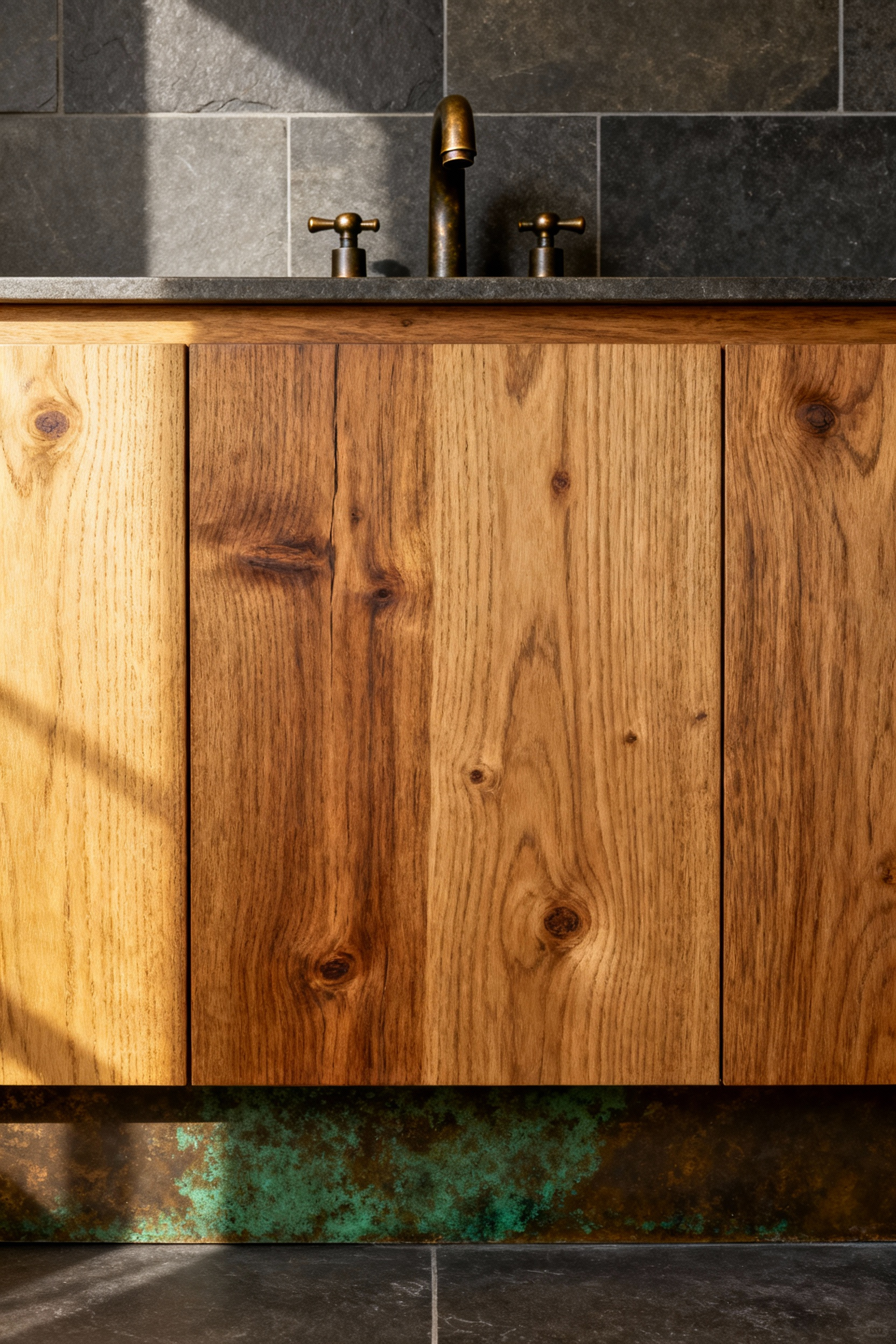
This philosophy extends to every surface. Natural stone like honed marble or slate will acquire a soft luster and subtle marks from years of use, telling a story on its surface. Walls finished with a true limewash offer a soft, mottled texture that feels ancient and adds a depth that flat paint can never achieve. The point is to select materials that absorb the passage of time gracefully, gaining character rather than just aging. It’s the difference between a desired patina and unmanaged decay. The intentionality lies in knowing how these materials will evolve and choosing them for that very journey.
4. Weaving a Coherent Design Chronology: Vintage Soul, Modern Smarts
The real artistry in a sophisticated farmhouse bathroom renovation lies in making different eras speak the same language. It’s about creating a space that feels historically grounded but functions with the effortless precision of today. This means weaving a coherent design chronology where vintage authenticity and modern performance coexist without conflict.
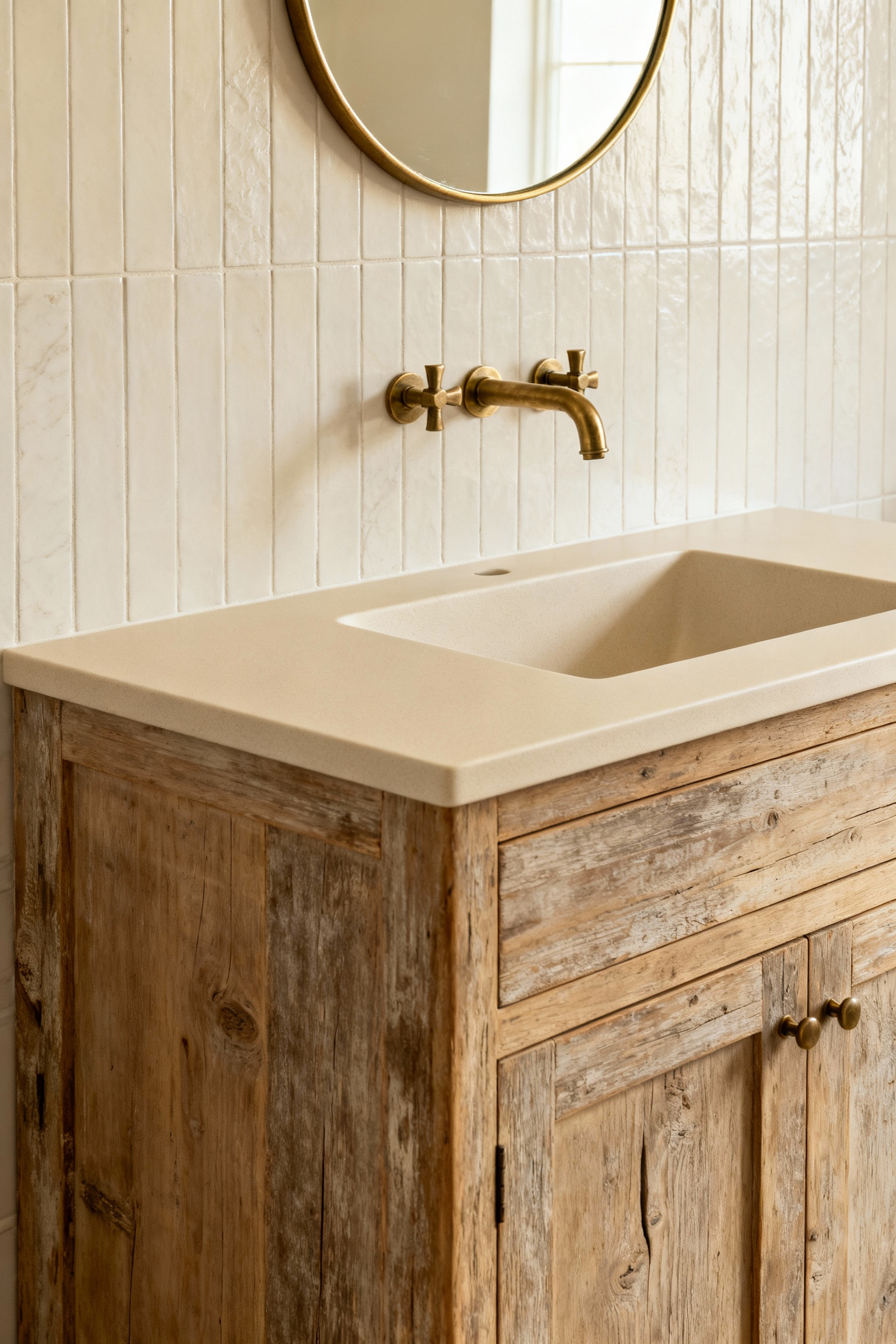
A perfect example is concealing modern tech within period-appropriate forms. Think of radiant heating coils silently warming hexagonal mosaic tiles underfoot. Or imagine a classic clawfoot tub—the icon of vintage charm—outfitted with a state-of-the-art thermostatic mixer that delivers a perfectly controlled water temperature. Lighting offers another fantastic opportunity: sconces with an industrial, turn-of-the-century feel can house advanced LED bulbs that are both energy-efficient and offer beautiful, warm light. It’s about leveraging modern engineering for durability, efficiency, and comfort, while the visual story remains rooted in the authenticity of the farmhouse ideal. This thoughtful fusion creates a bathroom that isn’t just a style statement, but a true sanctuary of curated comfort.
Architectonics of Authenticity: Deconstructing the Farmhouse Aesthetic (Part 2)
Now we move beyond the tangible objects to the intangible forces that shape the room: space and touch. These are the elements that dictate the feeling of a room, creating either a sense of calm serenity or restless clutter. Mastering them is essential for an authentic farmhouse bathroom renovation.
5. Using Negative Space as a Powerful Design Element
In the farmhouse aesthetic, what you don’t put in a room is as important as what you do. Negative space isn’t just emptiness; it’s a deliberate design element. It’s the visual pause that allows the chosen materials and objects to breathe and be appreciated. A successful farmhouse bathroom renovation is often defined by its restraint.
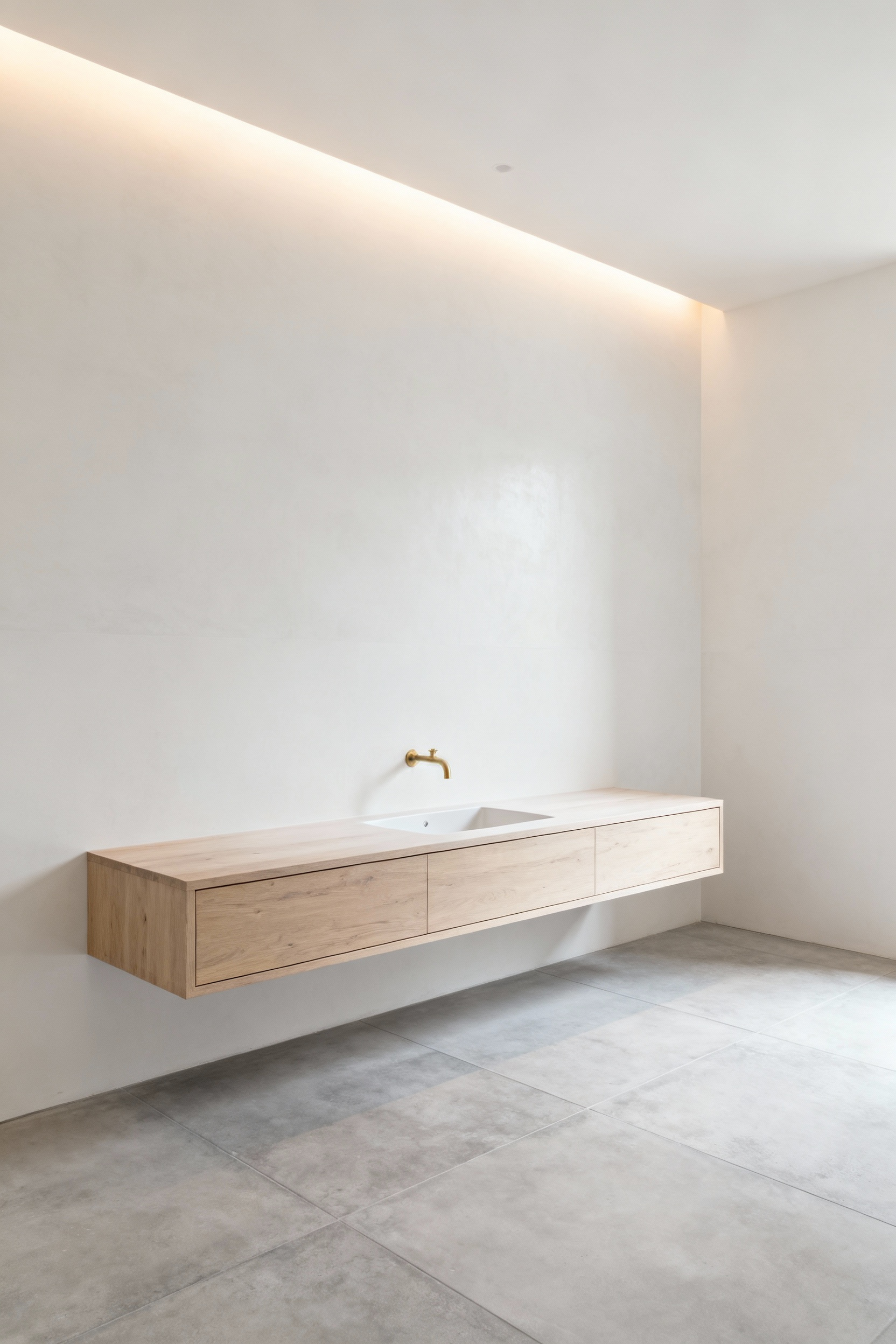
Instead of cluttered vanities and packed shelves, think of a curated minimalism that speaks with confidence. A floating vanity or a simple pedestal sink opens up the floor, making the room feel instantly larger and more serene. Open shelving, populated with a few beautiful and essential items, allows the eye to travel through the space rather than stopping at a solid cabinet door. And a single, meaningful piece of art on a bare wall has far more impact than a gallery of smaller pieces. By consciously designing these moments of quiet, you ensure the authenticity of your materials—that reclaimed wood beam, that perfect porcelain tub—gets the attention it deserves, defining an environment of unburdened elegance.
6. Designing a Somatosensory Landscape: The Power of Touch
Beyond what we see, a room’s success is measured by what we feel. The deepest resonance of a farmhouse bathroom renovation comes from its somatosensory landscape—the story it tells through touch. This is about curating materials that engage more than just the eyes, grounding the space in a physical reality. True farmhouse design is inherently textural.
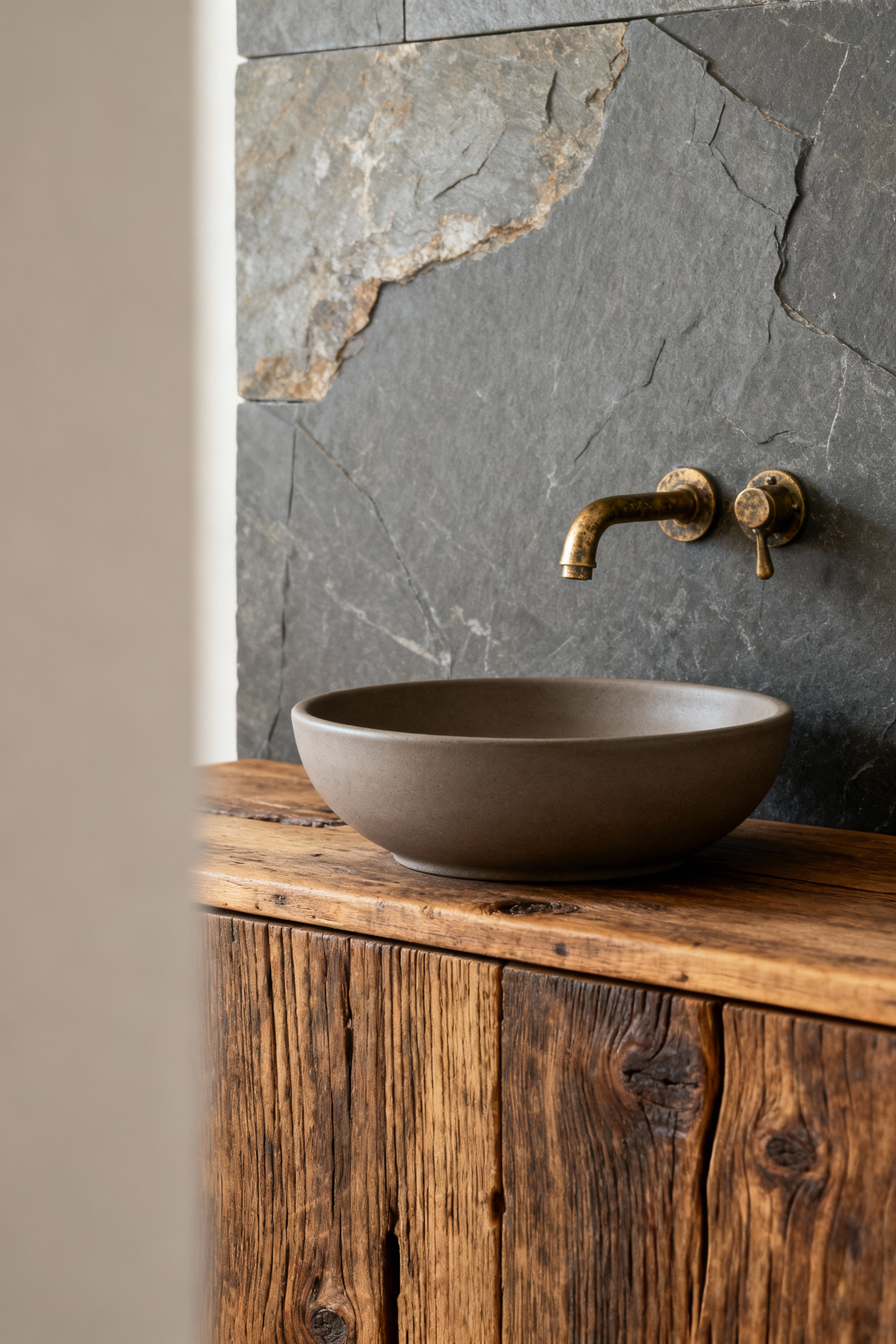
Start from the ground up. Instead of a glossy, uniform tile, consider a honed natural stone or a matte ceramic with slight imperfections. On the walls, vertical shiplap provides subtle shadow lines that invite the hand to trace them. Countertops made of soapstone, which develops a rich patina with touch and use, or butcher block with its inherent warmth, speak a language of utility and beauty. What I’ve noticed in my professional experience with surface design is that a room with varied tactile surfaces feels more complete, more human. It’s about understanding how these elements interact with the body—the coolness of stone underfoot, the heft of a brass handle, the slight coarseness of a linen towel. This haptic vocabulary forges a deep connection, making the space feel not just designed, but truly inhabited.
Kinetic Surfaces and Structural Veracity: Establishing the Core Aesthetic (Part 1)
With our foundational philosophy in place, we now turn to the core surfaces and structures that define the room’s character. These are the workhorse elements that dictate both the daily experience and the long-term appeal. This is where smart material choices create a space rooted in both beauty and function.
7. The Grounding Force: Resilient Flooring of Terracotta or Engineered Porcelain
The floor is the foundation of your entire design narrative in a farmhouse bathroom renovation. It sets the tone for both beauty and endurance. My go-to materials, which balance heritage charm with modern resilience, are impervious glazed terracotta and high-performance engineered porcelain. Terracotta, with its earthy warmth and subtle surface undulations, offers an immediate sense of history and craft. Its glazed surface provides a vital barrier against moisture, while its natural color variations create an organic, lived-in feeling.
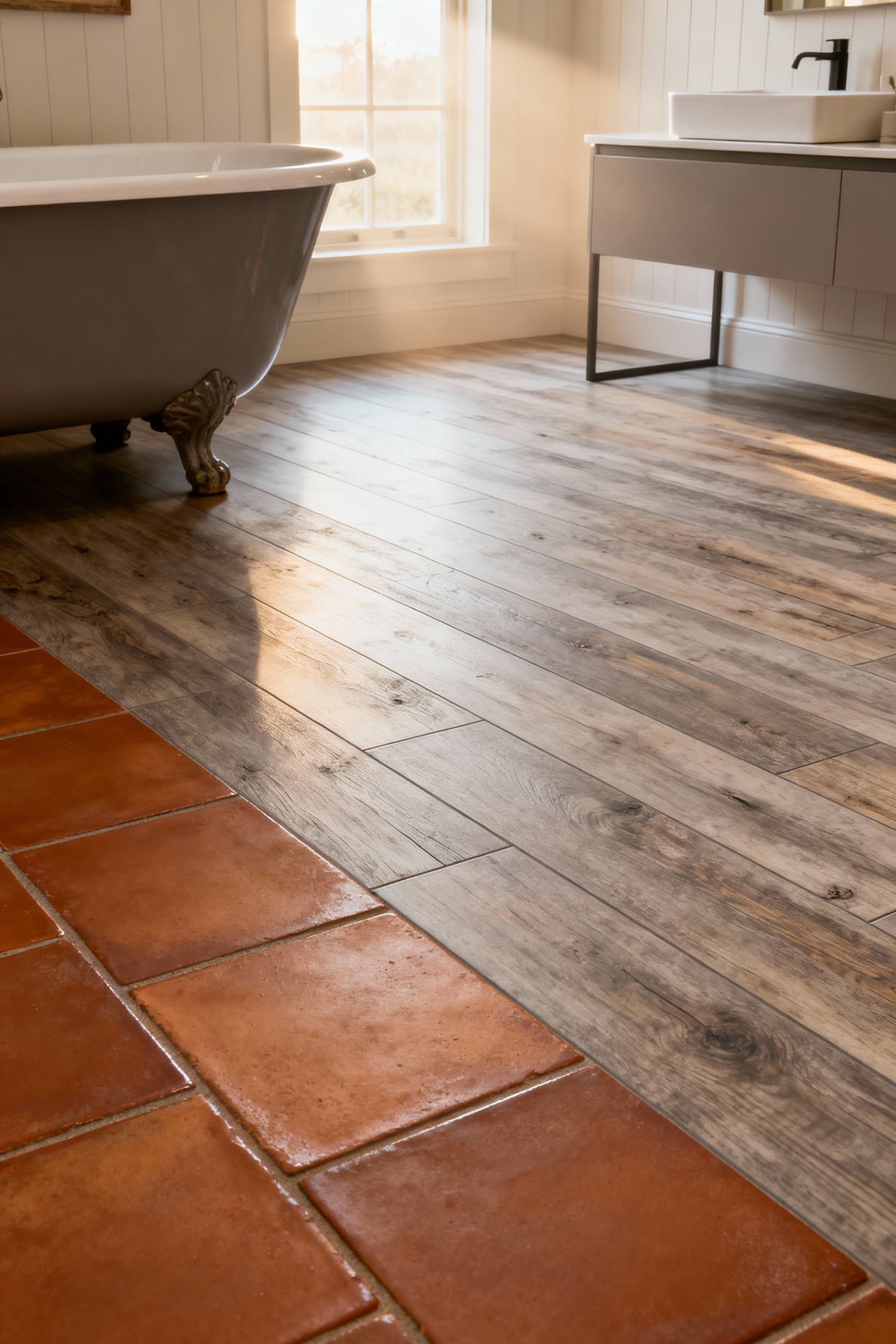
On the other side of the spectrum is engineered porcelain. Modern manufacturing has become so advanced that porcelain can replicate the look of natural wood or stone with stunning fidelity, but without their vulnerabilities in a wet environment. It is virtually impervious to water, staining, and scratching—an unbeatable trifecta for a high-traffic bathroom. For those who want the look of aged terracotta but need uncompromising durability, engineered porcelain is an elegant solution. The choice between them comes down to a simple question: how much authentic imperfection are you seeking, versus how much modern invincibility do you require?
8. The Rhythm of the Walls: Shiplap vs. Board-and-Batten
Wall treatments in a farmhouse bathroom are about creating rhythm and character. Shiplap, with its clean horizontal or vertical lines, imparts a sense of tailored craftsmanship and visual calm. The subtle shadow lines add texture and depth, providing a perfect backdrop for more sculptural elements like a freestanding tub or artisanal sconces. Orienting the planks horizontally can make a room feel wider, while a vertical application draws the eye up, creating a sense of height.
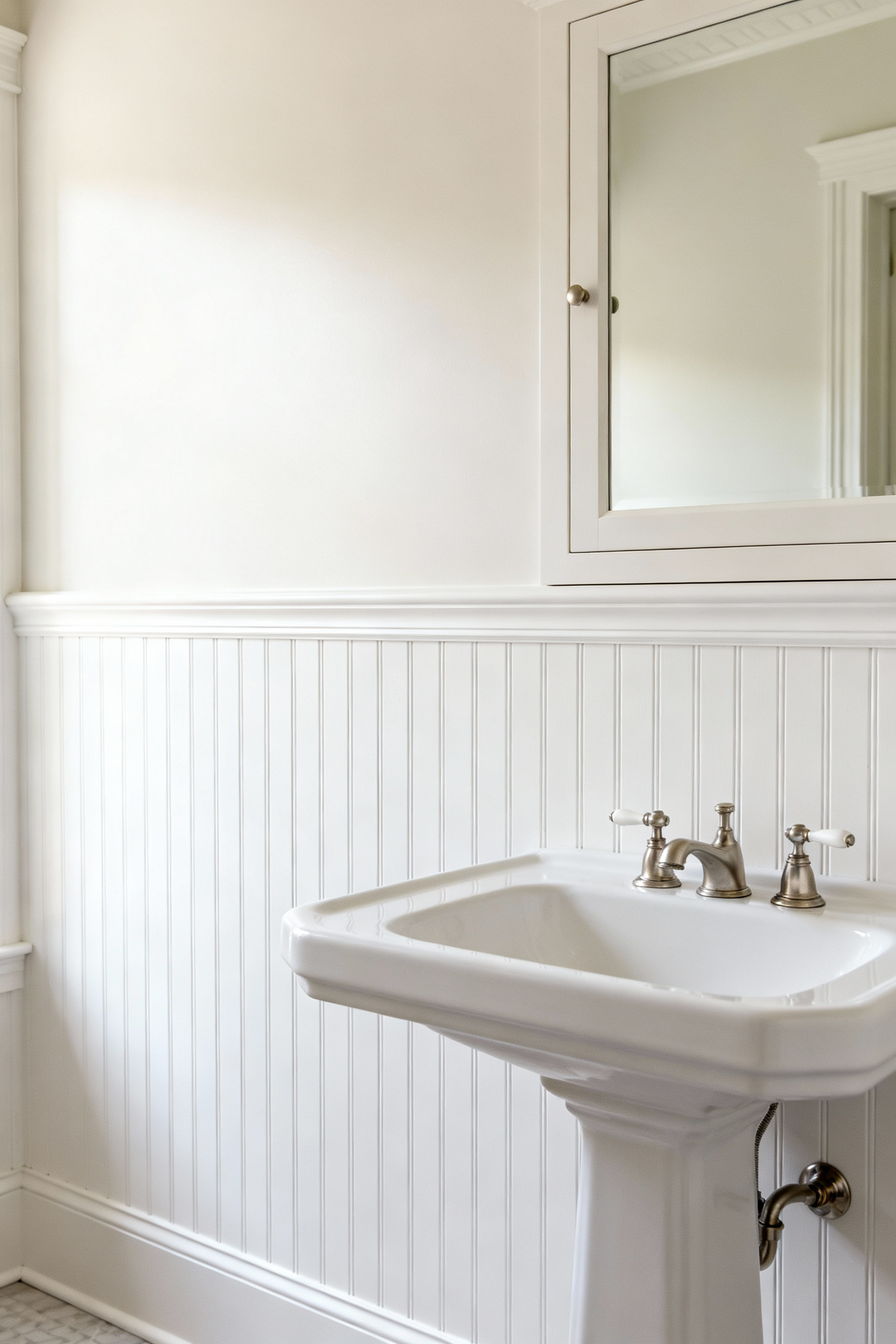
Board-and-batten, by contrast, offers a more robust, architectural statement. Its composition of wide boards punctuated by narrower battens feels structural and substantial. It brings a touch of formality and grandeur, especially when used as wainscoting on the lower half of the walls. What I tell my clients is to think of these treatments as the room’s percussion section. Shiplap is the steady, quiet beat, while board-and-batten is a more pronounced, resonant rhythm. The choice depends entirely on the energy you want the space to convey within your farmhouse bathroom renovation.
9. Lighting as Sculpture: Crafting Functional and Atmospheric Vignettes
Lighting in a farmhouse bathroom is so much more than simple illumination. It’s a tool for sculpting the space, creating mood, and ensuring flawless function. A well-designed scheme is layered, comprising ambient, task, and accent lighting. Ambient light, from a central flush-mount or a simple chandelier, sets the overall tone. Task lighting is the non-negotiable workhorse, especially around the vanity. Sconces placed at eye-level on either side of a mirror provide the best, most even, shadow-free light for daily routines.
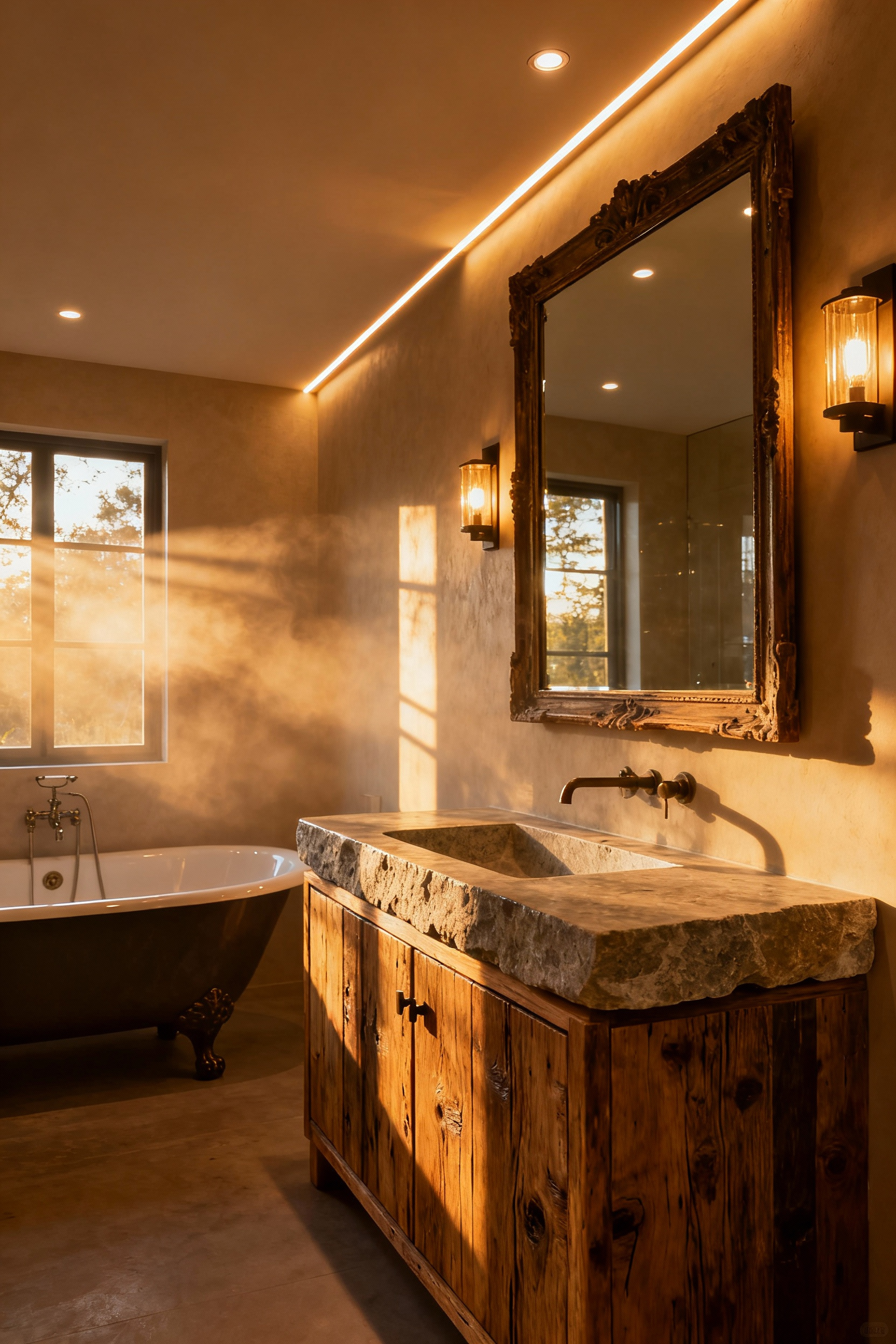
Finally, accent lighting adds the magic. A small spotlight can be used to graze a textured stone wall, highlight a piece of art, or catch the gleam of brass hardware, adding depth and focus. Dimmer switches on every circuit are essential; they allow you to transition the room from a bright, energizing space in the morning to a soft, restorative sanctuary in the evening. The fixtures themselves—whether aged brass, bronze, or matte black—should be chosen as sculptural elements that reinforce the design narrative, proving that the most functional elements can also be the most beautiful.
10. The Weight of Quality: Specifying Fixtures with Metallurgical Integrity
Fixtures are the jewelry of the bathroom. They are the primary points of physical interaction, and their quality—or lack thereof—is felt every single day. In a farmhouse bathroom renovation, they need to have a certain proportional gravitas, a sense of substance and permanence. This comes from genuine metallurgical integrity, which is why I always specify solid brass construction. It ensures longevity and provides a satisfying heft that simply can’t be faked.
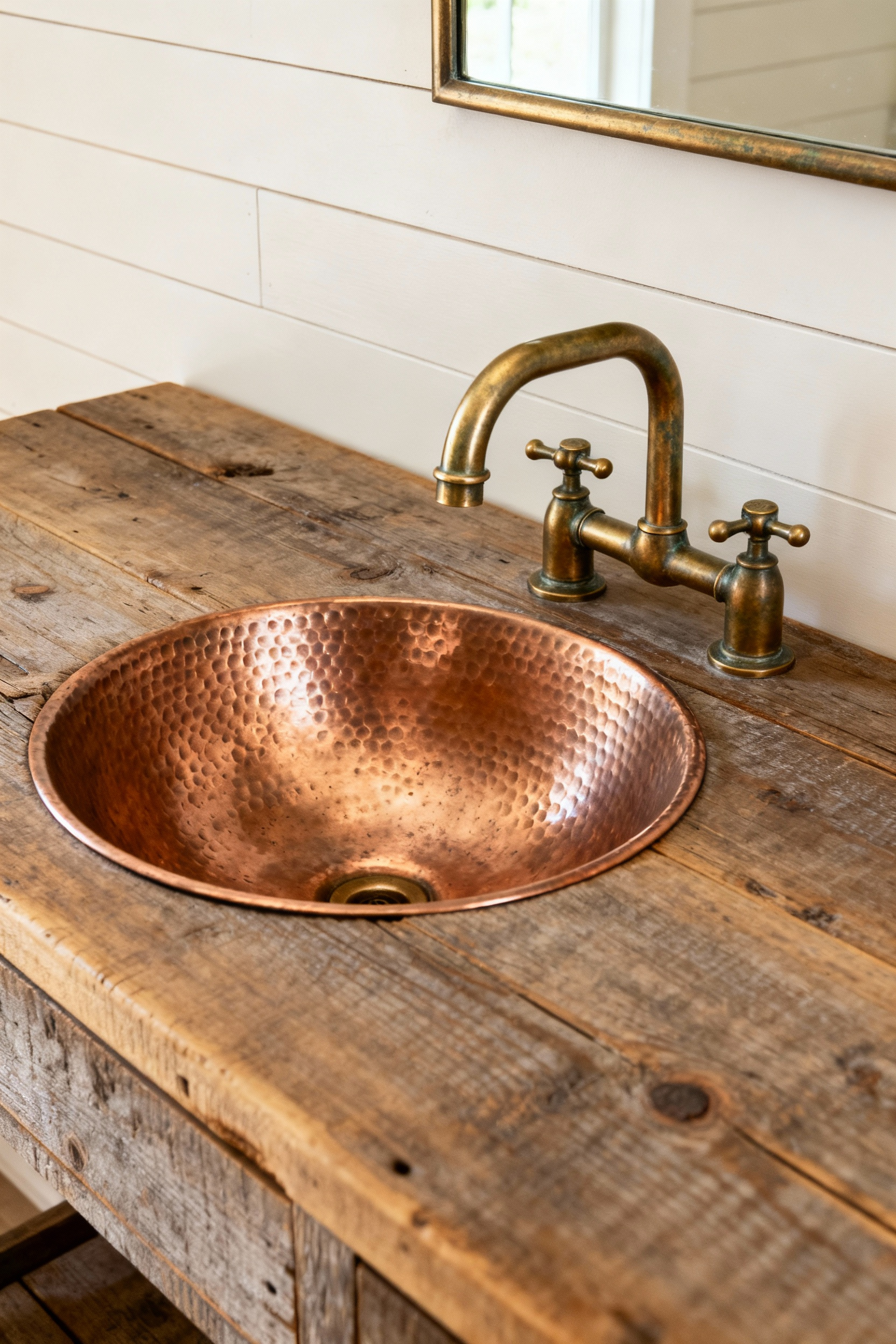
Look for materials with character. Unlacquered brass offers a “living finish” that will evolve and patina beautifully over time. Oiled-rubbed bronze has a timeless, weighty presence from day one. Even matte black, a more modern choice, feels substantial and sophisticated. The key is to match the scale of the fixture to its surroundings—a robust bridge faucet belongs on a substantial sink. Every turn of a handle should feel deliberate and solid. These are not just conduits for water; they are tangible expressions of a commitment to enduring quality.
Kinetic Surfaces and Structural Veracity: Establishing the Core Aesthetic (Part 2)
We continue our focus on the core elements by examining the bespoke features that become the true anchors of the room. From the custom vanity to the hardware that completes the story, these choices define the user experience and elevate the space from simply finished to truly authored.
11. The Bespoke Vanity: A Statement of Custom Joinery and Scale
In a truly considered farmhouse bathroom renovation, the vanity is never an afterthought. It is the room’s sculptural anchor, a testament to craftsmanship that defines the character of the space. A bespoke vanity, built with the precision of custom joinery, is a worthy investment because it can be perfectly scaled to the room’s specific dimensions, honoring sightlines and traffic patterns. This is something off-the-shelf options can rarely achieve.
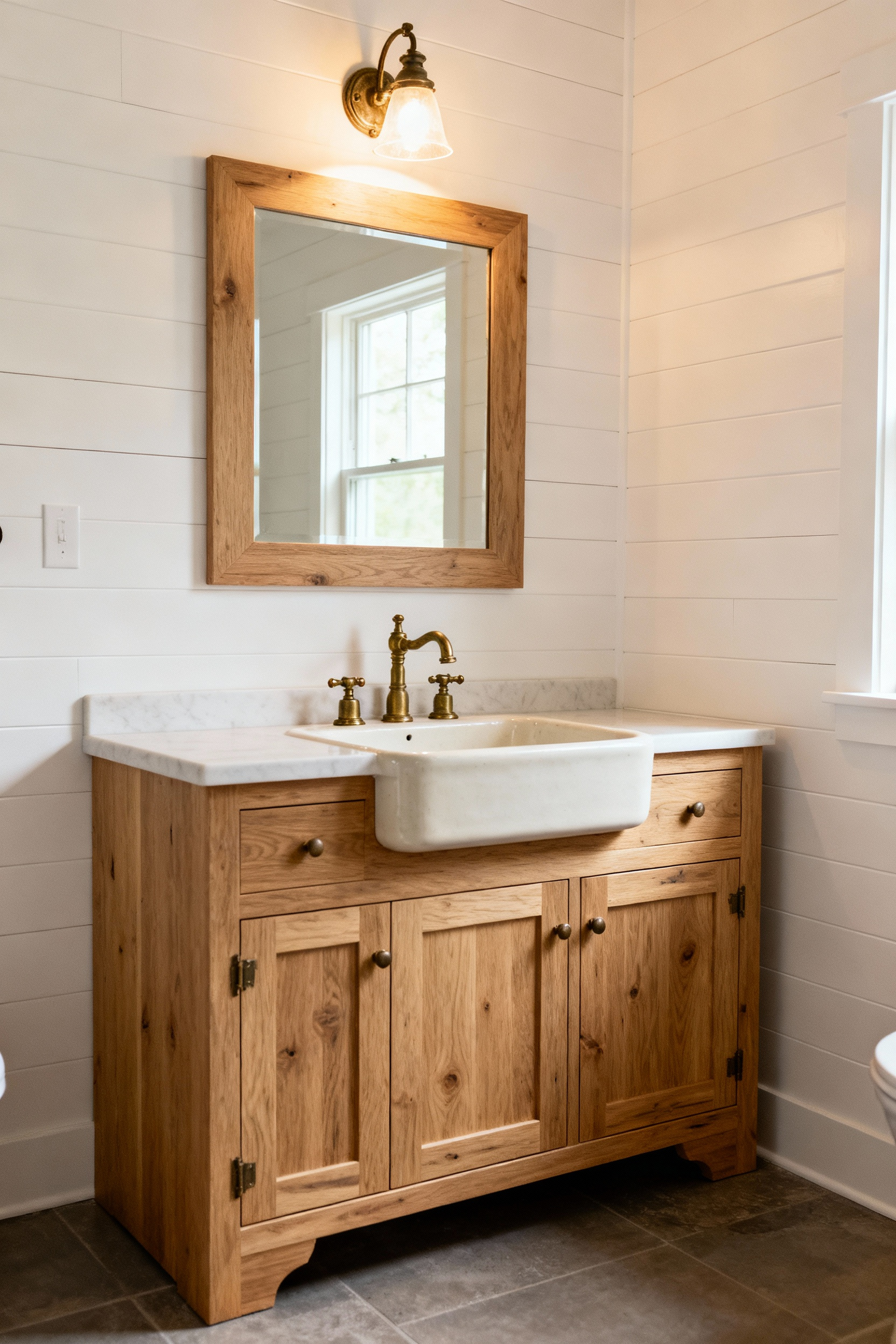
Materiality here is everything. Reclaimed oak, distressed pine, or rift-sawn white oak speak the farmhouse language fluently. Their natural textures and grain bring an immediate sense of warmth and history. Paired with a countertop of honed marble, durable soapstone, or even patinated copper, the vanity becomes a symphony of textures. Integrated storage designed with purpose—think dove-tailed drawers and soft-close hardware—ensures that the piece is as functional as it is beautiful. A bespoke vanity is the centerpiece that declares your commitment to lasting quality and discerning taste.
12. The Clarity of Glass: Delineating Wet Zones to Preserve Expansiveness
The impulse to enclose a shower shouldn’t mean carving up your bathroom into smaller visual chunks. In a farmhouse bathroom renovation, where a sense of openness is key, frameless glass partitions are the most elegant solution for delineating wet zones. Unlike framed enclosures or fussy shower curtains that chop up the space and block light, frameless glass creates an almost invisible boundary.
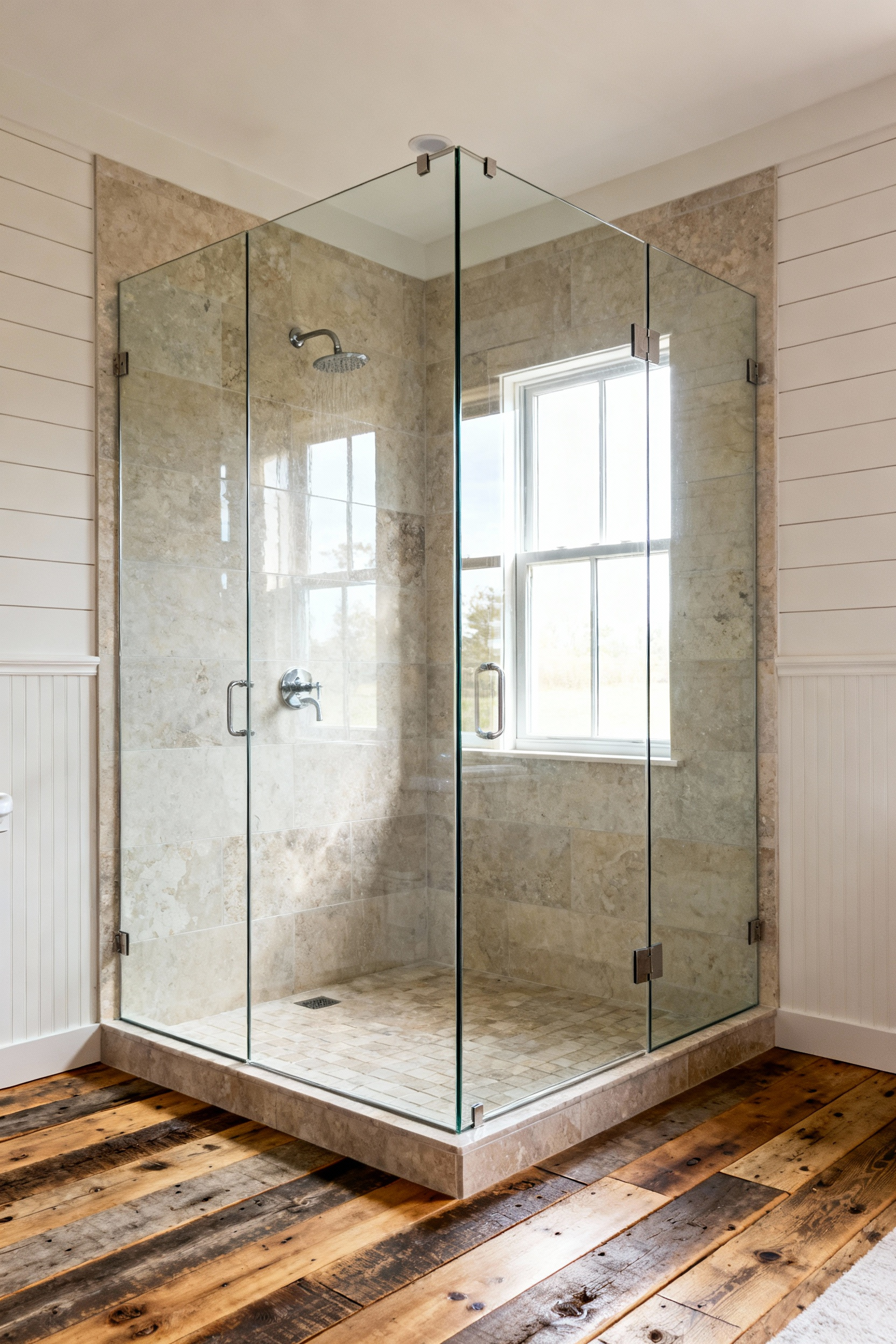
This transparency allows your wall treatments—whether beautiful tile or classic shiplap—to remain a continuous, uninterrupted feature, making the whole room feel larger and more cohesive. Using high-quality, thick tempered glass ensures a feeling of robust quality, and opting for a hydrophobic coating makes maintenance incredibly simple by repelling water and soap scum. This choice transforms a functional necessity into an architectural feature that celebrates, rather than conceals, the beauty of your material choices, reinforcing the serene and uncluttered ethos of the farmhouse style.
13. Precision in the Details: Faucet Ergonomics and Enduring Finishes
The daily satisfaction derived from a bathroom hinges on small details, and faucet selection is paramount. It’s about more than looks; it’s about operational ergonomics and the long-term resilience of the finish. Does the handle feel good in your hand? Is the water flow smooth and controlled? These are the questions that matter. Inside, look for high-quality ceramic disc valves, which ensure leak-free performance and durability for years to come.
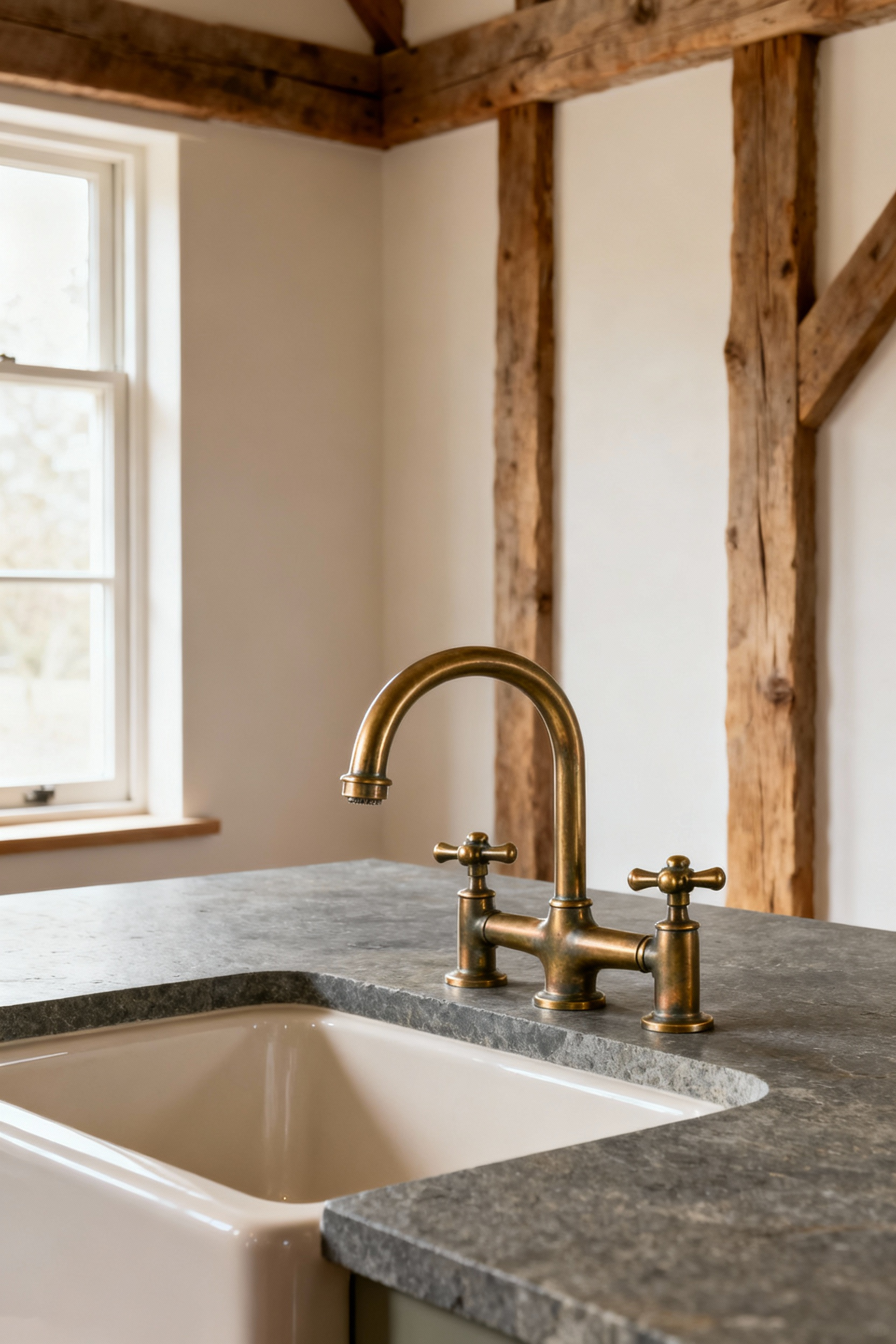
For finishes, unlacquered brass remains a favorite for its ability to develop a rich, personal patina over time, telling a story of use. But regardless of the finish you choose—be it aged bronze or brushed nickel—ensure you assess the practicalities. Check the spout’s reach and height in relation to your sink bowl to prevent awkward splashing. I learned this when a client chose a beautiful but short-spouted faucet for a deep vessel sink, and the result was a daily mess. A truly successful farmhouse bathroom renovation marries timeless design with flawless, intuitive engineering.
Transcendental Textures and Integrated Artistry: Elevating the Narrative (Part 1)
With the foundation set, we now layer in the elements that elevate the design from proficient to profound. This is where we introduce sophisticated textures and sculptural interventions that give the room its unique personality and a deep sense of place.
14. The Living Finish: The Sophistication of Oxidized Metals
True elegance is often found in the beauty of evolution. This is why, for a farmhouse bathroom renovation, I champion oxidized metals. Instead of seeking pristine, unchanging surfaces, we embrace the “living finish” of unlacquered brass, oiled bronze, and even raw steel. These materials are dynamic, changing over time in response to touch and atmosphere, recording the history of the room on their very surface.
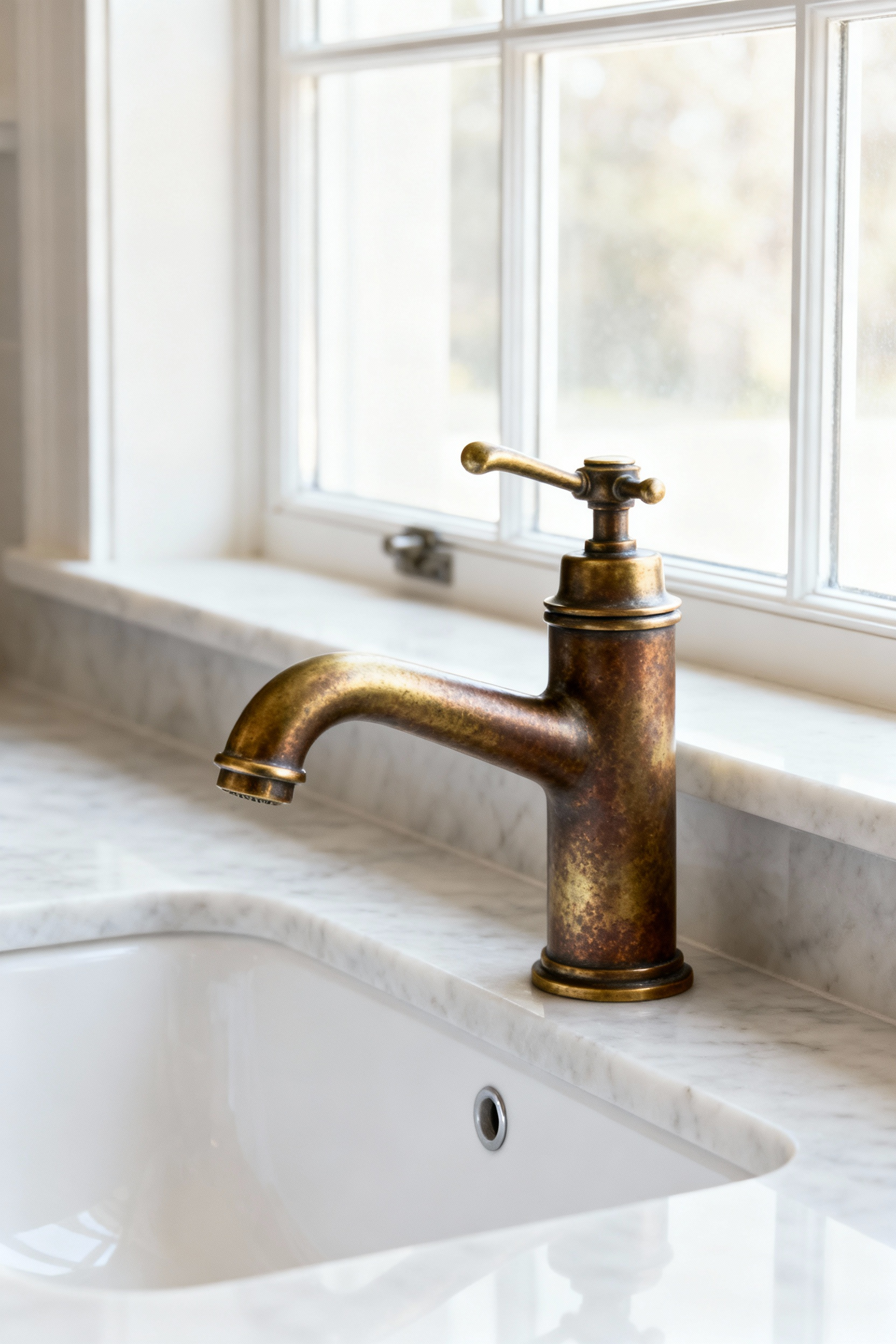
Unlacquered brass transitions from a bright gold to a deep, earthy brown, with highlights where it’s touched most often. Oiled bronze offers a rich, antique charm from day one that only deepens with age. This micro-textural approach goes beyond faucets to cabinet pulls, switch plates, and mirror frames. The tactile experience of these patinated surfaces fosters a connection to craftsmanship that is central to the farmhouse aesthetic. Their so-called “imperfections” are, in fact, hallmarks of authenticity, telling a story of thoughtful design and enduring beauty.
15. Botanical Sculpture: Using Live Flora as Dynamic Biophilia
Plants in a bathroom should be more than a simple decorative afterthought. They should be a sculptural intervention, a dynamic expression of biophilia that brings life and movement into the space. The humid environment of a bathroom is an ideal home for many plants, allowing you to create a lushness that might be difficult to achieve elsewhere.
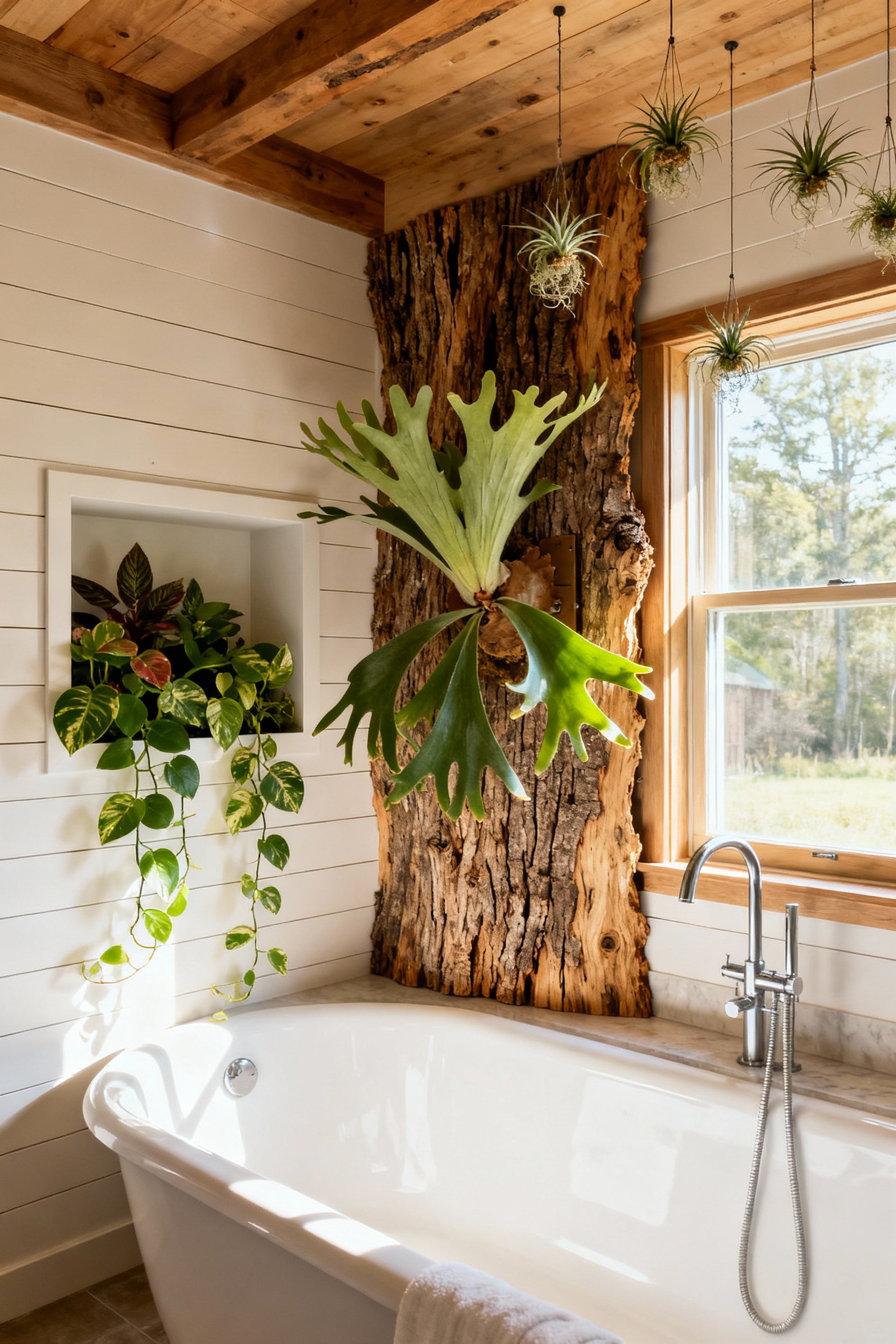
Think architecturally. A towering Bird of Paradise in a corner can act as a natural sculpture against a clean tiled wall. The delicate fronds of a Boston fern spilling from a vintage pot on a high shelf offer a softer, cascading form. Even a simple, heavy bundle of fresh eucalyptus in a ceramic vessel contributes visual texture and a subtle, invigorating scent. This is about purposeful integration, selecting plants whose form, scale, and texture complement the inherent strength of the farmhouse design, infusing the meticulously crafted environment with an undeniable sense of vitality.
16. The Luminous Countertop: Calacatta Gold Marble or Honed Quartzite
The vanity countertop is a focal point, a horizontal plane that can inject an immense amount of character and light into a farmhouse bathroom renovation. For a truly elevated look, my top recommendations are Calacatta Gold marble and honed quartzite. Calacatta Gold is pure drama—a luminous white field with broad, sweeping veins of gold and gray. Its natural translucence gives it a unique luminal depth, making it feel both opulent and organic. The warm gold veining harmonizes beautifully with wood tones and brass fixtures.
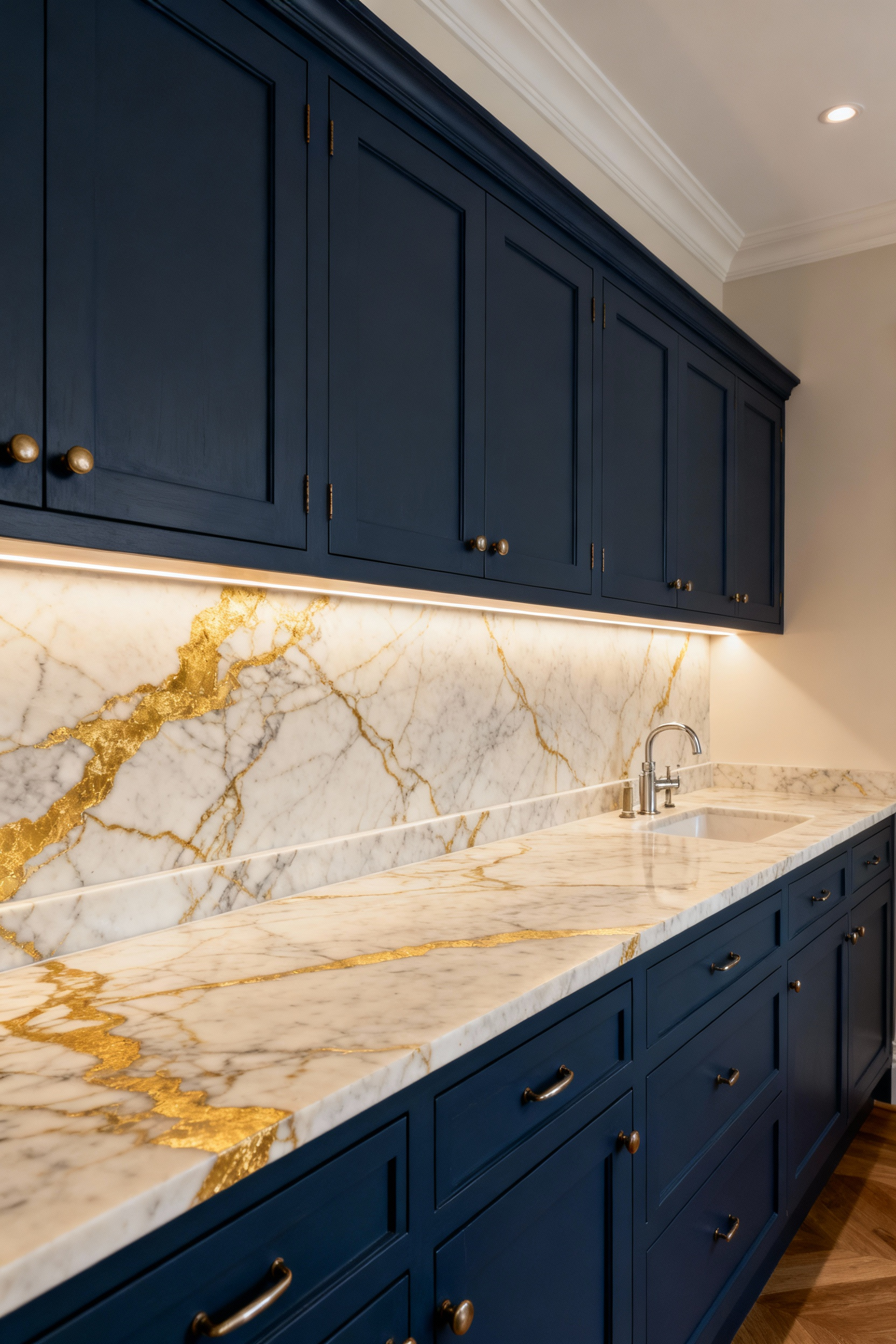
For those who prioritize durability without sacrificing beauty, honed quartzite is a superb choice. It’s a natural stone with the hardness of granite, making it exceptionally resistant to scratching and etching. The key is the honed finish. Unlike polished stone, a honed surface is matte and velvety, diffusing light softly and offering an understated, tactile elegance. Both of these materials provide a stunning point of refined materiality that stands in beautiful contrast to the more rustic elements in the room.
17. Walls that Breathe: The Subtle Depth of Limewash and Venetian Plaster
To create a truly immersive backdrop, move beyond conventional paint. Artisanal wall treatments like limewash and Venetian plaster offer a subtle depth and character that transforms a room. Limewash, made from slaked lime, creates a soft, chalky, cloud-like texture that interacts beautifully with natural light. It feels ancient and mineral, as if the wall itself is breathing. It’s the perfect canvas for a serene, authentic farmhouse feel.
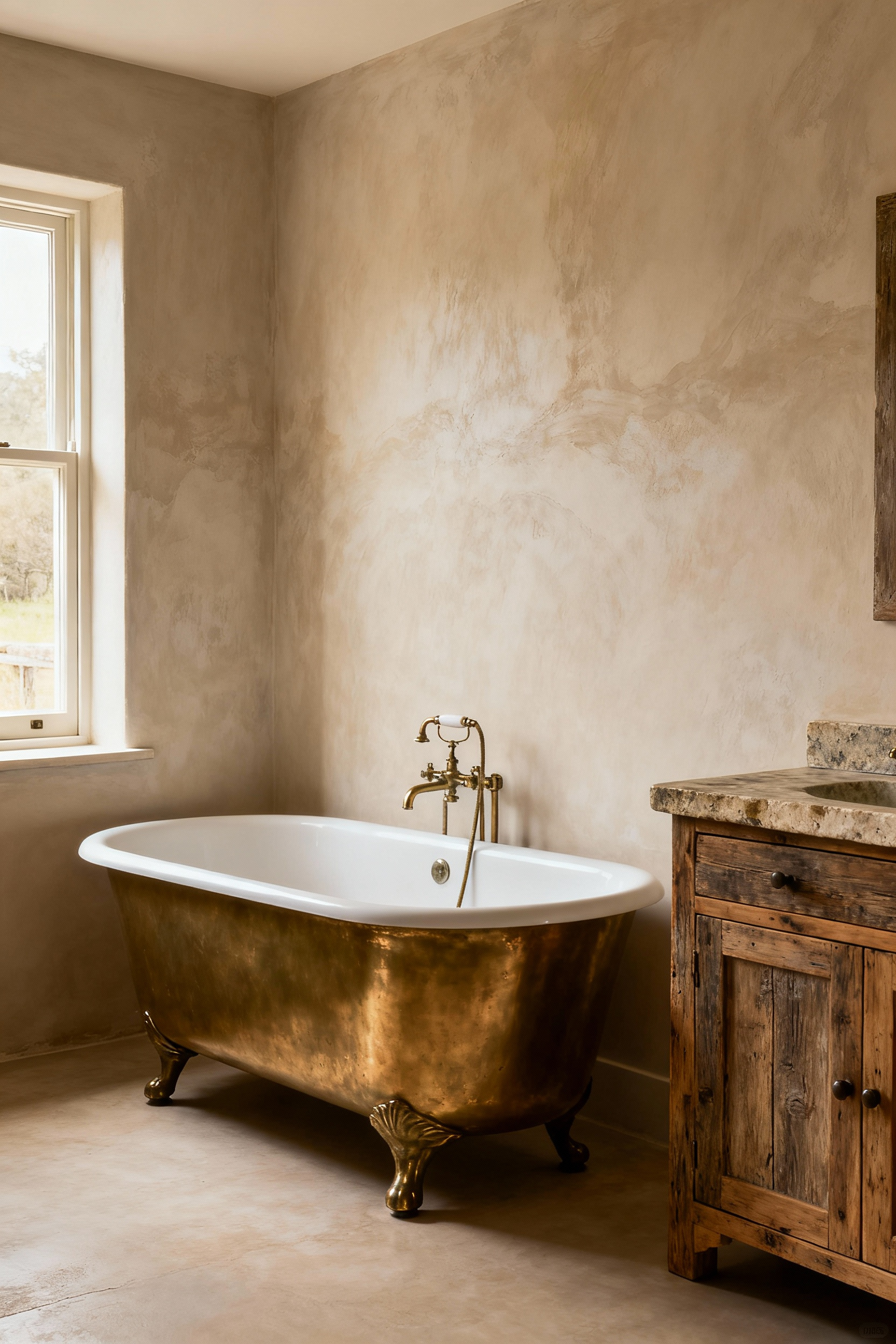
Venetian plaster, which incorporates marble dust, offers a greater potential for sheen and depth. Applied in thin, burnished layers, it creates a smooth surface with the visual complexity of aged stone. It feels cool, refined, and incredibly sophisticated. In my professional experience, these finishes change the entire sensory dynamic of a room. They add a tactile dimension that invites touch and creates a lived-in, layered feeling that flat paint simply cannot replicate, turning your walls into an active part of the design narrative.
Transcendental Textures and Integrated Artistry: Elevating the Narrative (Part 2)
We conclude by focusing on the crucial, often invisible, details that ensure the longevity of your design and the richness of your daily experience. This is where we lock in the beauty through smart protection, manipulate light for maximum effect, and add the final layers of tactile comfort.
18. Material Stewardship: Advanced Sealing and Maintenance Protocols
The lasting beauty of a farmhouse bathroom renovation depends on what happens after the installation. True material intelligence means planning for longevity through rigorous prophylactic measures. Natural stone like marble is porous and needs a high-quality penetrating sealer—not a topical one—to protect it from staining from within. This process must be repeated periodically as part of a diligent maintenance protocol.
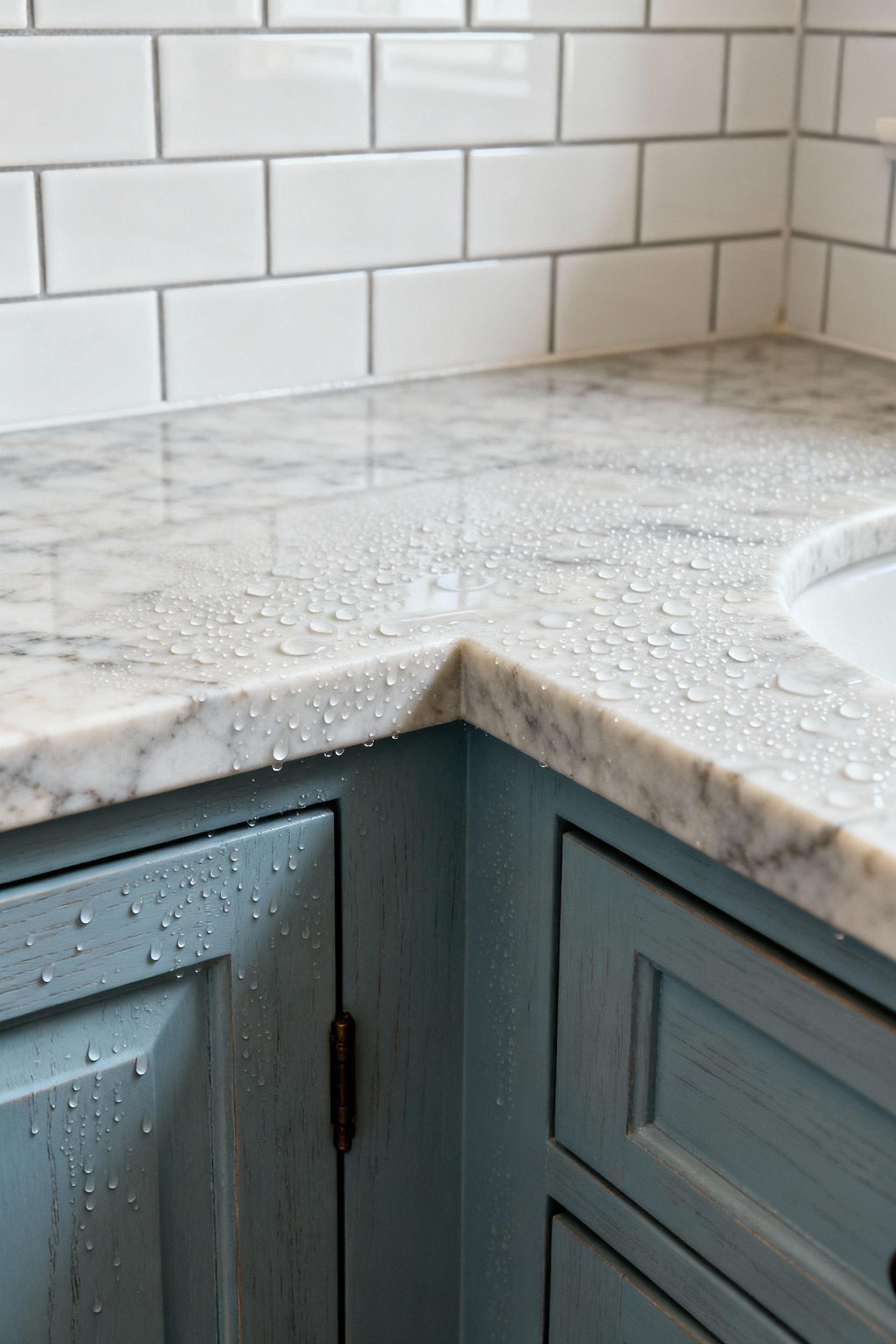
The same goes for wood. A vanity made from reclaimed barn wood needs more than a standard polyurethane. A marine-grade varnish or a hardwax oil provides superior protection against humidity while enriching the wood’s natural grain. Even grout lines, often the first place to show wear, benefit from an epoxy-based sealer that offers a more robust barrier against moisture and mildew. This isn’t just cleaning; it’s a form of material stewardship, a respect for the elements you’ve chosen that ensures their beauty will endure for generations.
19. The Magic of Reflection: Antiqued Mirrors to Expand Space and Refract Light
Mirrors are not just for checking your reflection; they are powerful tools for manipulating light and space. In a farmhouse bathroom renovation, antiqued mirror panes can be transformative. Unlike a standard clear mirror, an antiqued surface has a subtle mottling that diffuses light, creating a softer, more atmospheric glow that complements the rustic aesthetic beautifully.
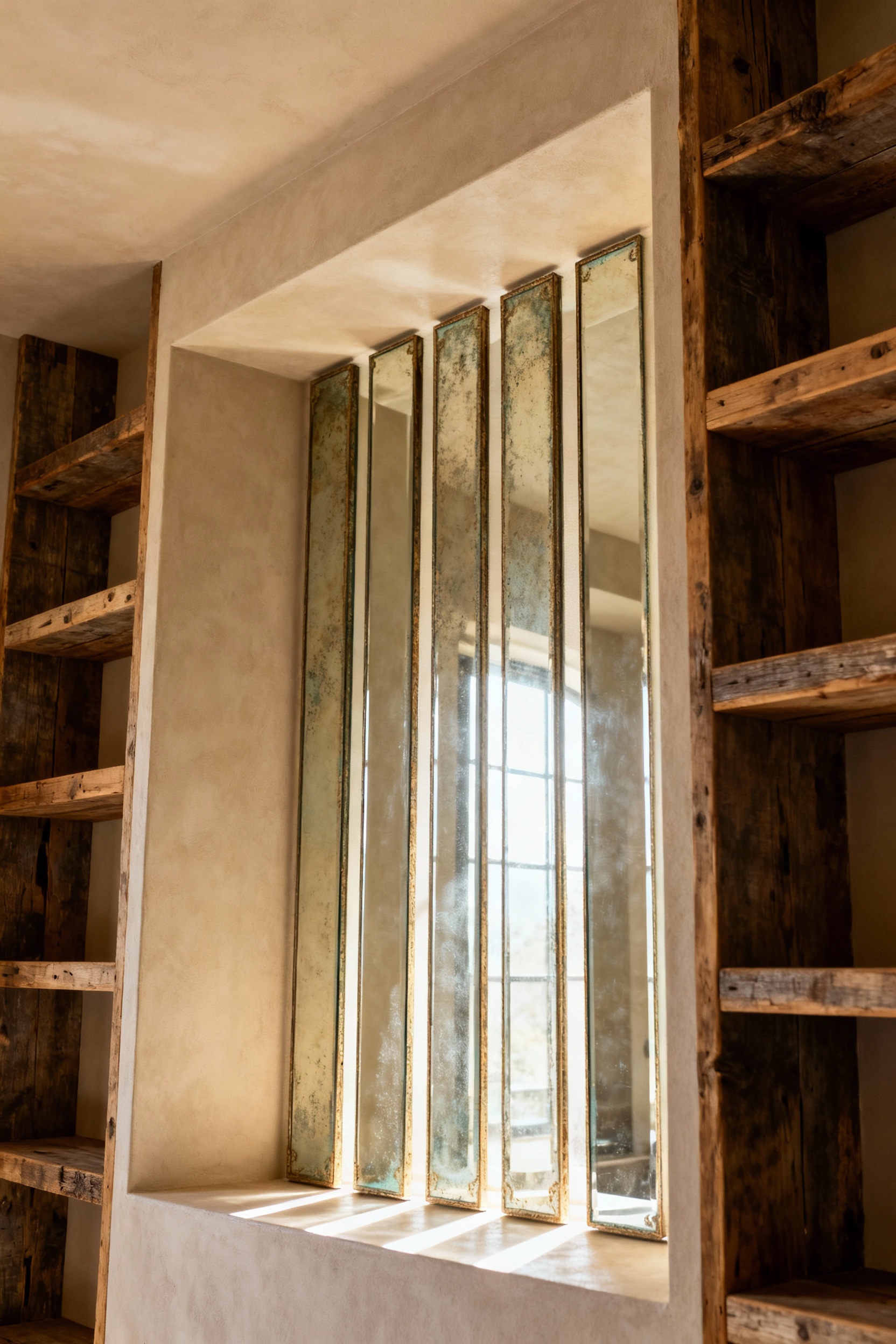
Strategic placement is everything. A large antiqued mirror across from a window will capture and redistribute natural light, making the entire room feel larger and more luminous. Consider using them as inserts in cabinet doors to break up a solid run of wood and add a bit of unexpected sparkle. Or use antiqued mirror tiles as a backsplash behind a freestanding tub to create a dynamic, ever-changing focal point. This is a sophisticated way to add depth, magic, and a sense of history to your space.
20. The Final Layer: Layered Textiles for Acoustic and Tactile Softness
The final touch in any room, and one that’s often overlooked in a bathroom, is the thoughtful layering of textiles. Hard surfaces like tile and stone can create a cold, reverberant space. Textiles are the solution, adding crucial acoustic softness and tactile warmth. Start with waffle weave linen towels and a beautiful linen shower curtain. The three-dimensional texture is wonderfully absorbent and visually inviting, providing a soft counterpoint to hard surfaces.
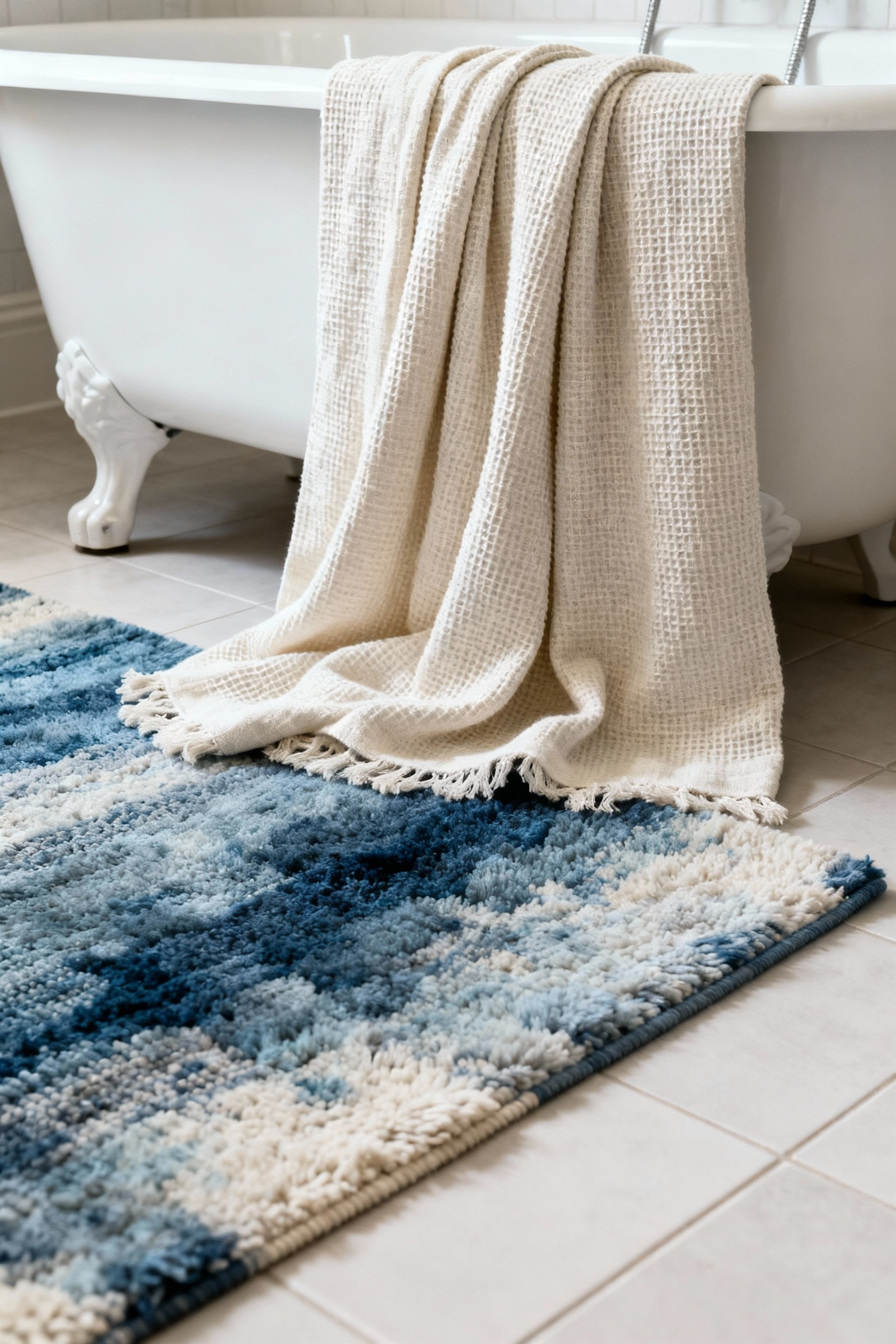
Ground the space with a hand-dyed rug. Unlike a synthetic bathmat, a beautiful wool or cotton kilim runner in front of the vanity adds color, pattern, and an artisanal touch. But more importantly, it absorbs sound, dampening echoes and creating a hushed, serene atmosphere. This final layer of sensory richness is what transforms a well-designed bathroom into a truly inviting and comfortable retreat, completing the immersive appeal of a masterfully executed farmhouse bathroom renovation.
Conclusion
As we’ve journeyed through these twenty truths, it’s clear that exceptional design is an act of thoughtful synthesis. A farmhouse bathroom renovation, when done with intention, is not a superficial collection of trendy items. It is the physical manifestation of an idea—an idea about comfort, authenticity, and enduring beauty. Each material choice, from the foundational flooring to the living finish on a faucet, contributes to a cohesive narrative. It’s a space that should feel as though it has always been there, perfectly suited to its purpose and its people.
The ultimate goal is to move beyond mere aesthetics and cultivate an atmosphere. You are crafting a personal sanctuary, and the principles we’ve explored—balancing rustic forms with modern function, curating texture and patina, and respecting the inherent properties of each material—are your guide. I encourage you to approach your own project with this discerning intent. Build a space that tells your story through the language of materials. In the end, the success of your design will be measured not just in how it looks, but in the quiet, profound sense of rightness it evokes every single day.


